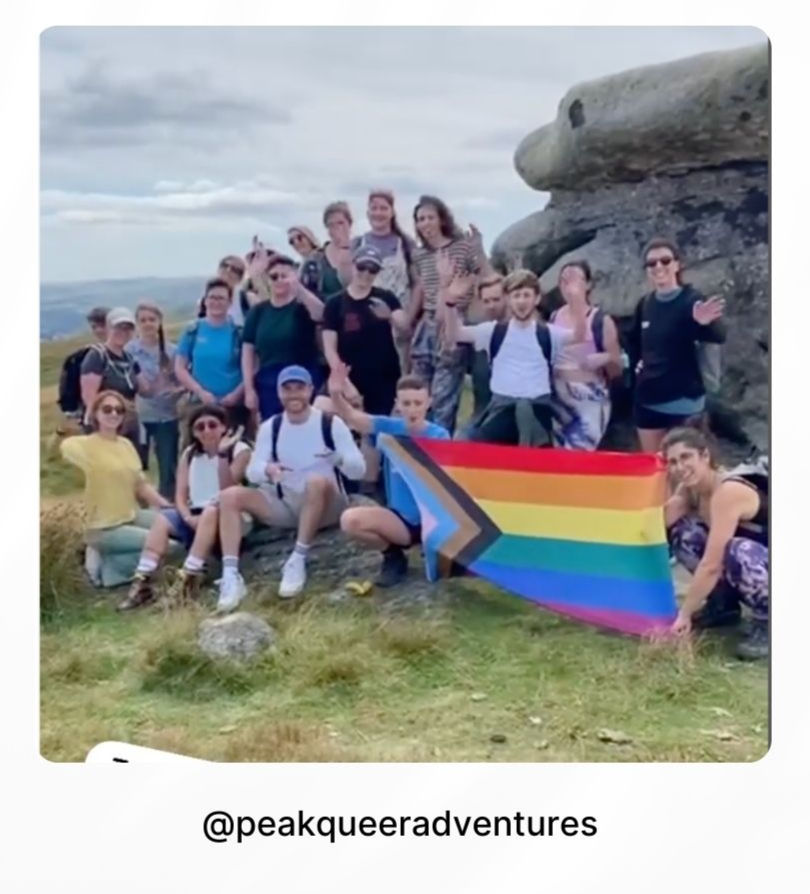Belonging in the Woods: What Forest School Can Learn From Queer Adventure
- Lizzie

- Jul 19
- 4 min read
A few months ago, my first academic article was published in the Journal of Adventure Education and Outdoor Learning.
Queering Adventure: Building Communities Outdoors to Combat Social and Environmental Injustice (2025), explores the experiences of LGBTQIA+ folks in outdoor groups and how they build spaces of safety, identity, and resistance in nature. I explored how LGBTQIA+ outdoor adventure groups actively dismantle historical barriers, such as heteronormativity and masculine-centred traditions, and cultivate community in green spaces (like hills, mountains and of course woodlands) and blue spaces (like the sea and rivers) through inclusive practices and queer ecology. By combining survey data, interviews, field observations, and social media analysis, my research revealed how such groups foster intersectional identities, a sense of belonging, and hope among participants. The paper highlighted the role of intentional community-building—rituals, storytelling, visible role models, and inclusivity—in advancing both social and environmental justice for sexual and gender minorities as well as those with intersectional marginalisations.

The findings offered rich lessons for any space aiming to centre inclusion, and this can be applied to our Forest School Practice.
You can read the full paper here https://www.tandfonline.com/doi/full/10.1080/14729679.2025.2486841

Outdoor spaces often feel open and welcoming, but for many marginalised people, they aren’t. The LGBTQIA+ people in our study spoke about deep fears: being misgendered, excluded, or unsafe. What helped them stay wasn’t just the outdoors, it was the communities that were built out there. It was the focus on building shared experiences and queer joy. Being able to just be, not asked awkward questions but to also share lived experiences with those who understood.
In Forest School, we need to remember this: the space may be open, but inclusion must be created. It takes work, and that work starts with us.
Inclusion at Forest School
Although my research focusses on a specific marginalised group, the lessons can be used to support many different groups of people to repair their relationships with nature. We know that people from marginalised groups suffer from disproportionatly poor mental health outcomes and, as Forest School leaders, we see every day how good Forest School is for mental health. That's why this matters so much.
These are some thoughts that you could take away from my research and apply to your own practice.
Make emotional safety visible
Barriers to participation aren’t always physical. Fear, shame, or the feeling of not belonging are also barriers that many face.
How could you make emotional safety visible?
Be open and welcoming, long term programmes really build that sense of emotional safety that is so important to all our learners
Respect names and pronouns
Let children opt out without pressure - this is the bedrock of Forest School practice anyway, it's why Forest School is so great for those who are taking emotional and social risks
Build intentional community - with inclusion at the heart
Queer outdoor groups created inclusive communities through storytelling, celebration, and chosen family.
Can Forest School do the same?
Honour differences through storytelling and food sharing
Build communities outdoors through long term programmes built on connections. The phrase "it takes a village to raise a child" feels so important to me at Forest School.
Use queer ecology to celebrate the diversity of all of nature
At Forest School we are reconnecting people with nature, remembering that we are part of the wonderful natural world. Queer ecology reminds us that if queerness is unnatural, then nature itself is unnatural by that very definition.
How can we use queer ecology at Forest School?
Share the queerness of nature with your learners. Yew trees change sex, even after thousands of years of being male they can start growing berries! Split gill fungi have around 25,000 different sexes, bats have gay pairings.
Use they/them pronouns for different plants and animals. Normalise asking bugs what their pronouns are.
Bring in books, stories, and artefacts that reflect a wide range of identities.
Consider sessions for particular marginalised groups
Inclusion is amazing. I wish we lived in a world where inlclusion always worked, where no one judged, everyone was safe and we all started with the same opportunties in life. But we don't. We are all working towards social justice, but in the mean time my research clearly demonstrated that groups that are only open to certain marginalised groups are still needed. Muslim women's walking groups, trans swimming groups, queer walking groups, groups for neurodivergent children and so on represent a chance to lower risks and increase participation. They can be a gateway to more inclusive groups.
I can give many examples from the past 17 years - i have heard microaggressions in my sessions frequently, people being left out because no one knows how to approach them, awkward questions about identity, misgendering, assumptions, people saying "I don't see colour". Sometimes people just want to hang out and know it will be safe.
How do you do this in your setting?
If you belong to a marginalised group - set one up.
If you don't, do you have any members of your community who would run one with you (pay them please!)

As Forest School leaders we love to believe that nature itself is inclusive - and that is true! But as leaders we enter with all our internal biases, values, expectations and beliefs. Therefore, in order to create truly inclusive spaces, Forest School must be intentional. We must embrace difference—not just accommodate it. We must challenge stereotypes, shift our language, and centre the people who have always been on the margins.
Right now, this feels more important than ever.
To learn more:




![[Bio] Diversity in picture books](https://static.wixstatic.com/media/1314c4_e314b34178ac492c942fda42f4346502~mv2.png/v1/fill/w_980,h_490,al_c,q_90,usm_0.66_1.00_0.01,enc_avif,quality_auto/1314c4_e314b34178ac492c942fda42f4346502~mv2.png)
Comments